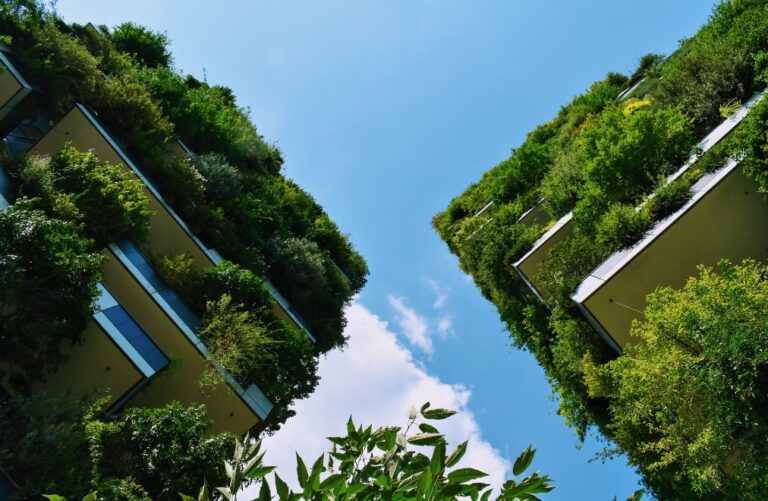Carbon-neutral architecture is emerging as a vital component in the global effort to combat climate change, marking a significant shift in the construction industry’s approach to sustainability.
This architectural philosophy champions climate-friendliness and sustainable practices by aiming to minimize or eliminate greenhouse gas emissions during all phases of a building’s life cycle, from design to operation.
It represents a commitment to a future where our buildings have a neutral impact on climate change, balancing their existence with the health of our planet.
Table of Contents
What is carbon-neutral architecture?
At its core, carbon-neutral architecture is an architectural and design movement focused on reducing the carbon footprint of buildings. It involves creating structures that either produce zero net carbon emissions or offset their emissions through renewable energy and other sustainable practices.
This approach encompasses everything from the choice of materials and energy sources to the design’s overall efficiency and integration with the environment. By achieving carbon neutrality, these buildings strive to be part of the solution to climate change, rather than a contributing factor to it.
The sobering reality of real estate’s environmental impact underscores the increasing importance of carbon-neutral architecture. With the International Energy Agency reporting that 40% of global emissions stem from the built environment, the role of architects and developers in reversing this trend is undeniable.
This responsibility extends beyond individual buildings; carbon-neutral architecture also looks at how a building’s design can influence and reduce emissions at a neighborhood or even city-wide level. For example, designs that promote the use of public transport or walking directly address significant sources of CO2 emissions, like vehicle usage.
Why is carbon-neutral architecture important?
Carbon-neutral architecture goes beyond environmental stewardship; it’s a smart, forward-thinking approach that benefits both the planet and the financial bottom line of developers and property owners.
1. Cost savings
First and foremost, carbon-neutral design is a gateway to significant cost savings. The real estate sector is a major contributor to global CO2 emissions, representing not just a challenge, but a substantial opportunity for savings. By adopting carbon-neutral principles, developers can reduce the emissions of their buildings. This reduction translates into lower operational costs, especially in essential services such as heating, ventilation, air conditioning (HVAC), and sustainable lighting.
Consider the implementation of sensor-based lighting systems. These systems, which activate lights based on motion or ambient light levels, ensure that electricity is used only when necessary.
By reducing the reliance on artificial lighting, especially in well-lit or unoccupied spaces, developers can significantly reduce energy costs. Achieving carbon neutrality doesn’t just help the environment; it also makes financial sense by reducing power bills.
2. Appeal to younger renters
Another key reason carbon-neutral architecture is important is its growing appeal among younger demographics, such as Millennials and Generation Z. These groups are increasingly climate-conscious, often considering the sustainability of their choices before making decisions.
Forbes reports that over half of Generation Z weighs sustainability heavily before making purchases. This trend is extending into the real estate market as well.
As these younger generations enter the workforce and become a larger segment of the renter population, properties with carbon-neutral credentials are likely to be more attractive to them.
By integrating carbon-neutral practices into property management and development, landlords and developers can align with the preferences of these environmentally conscious renters, ensuring their properties remain competitive and desirable in an evolving market.
Read also: Stockholm Wood City: from Sweden the world’s largest wooden neighborhood
How to develop carbon-neutral buildings
Developing carbon-neutral buildings is a multi-faceted process that involves thoughtful planning and innovative design strategies. Here are three effective ways to achieve carbon neutrality in building development:
1. Utilize sustainable building materials
Opting for sustainable building materials is a critical step towards carbon neutrality. Surprisingly, these materials can be more cost-effective than traditional ones. For example, wood framing is gaining popularity beyond small structures thanks to innovations like lamination, which enhance its viability. Wood, being lighter than steel, significantly reduces transportation costs.
Additionally, pre-assembling wooden frames before they reach the construction site can shorten building time, leading to further savings. Using sustainable materials like wood reduces the carbon footprint and brings economic benefits.
2. Zone properties for mixed-use
Carbon neutrality can be achieved beyond the construction phase. Transitioning to a mixed-use design for existing properties can greatly contribute to this goal. Mixed-use buildings combine residential, commercial, and sometimes industrial spaces, enabling residents to access various services without leaving the building.
This design reduces the need for car travel, thus cutting down on vehicle-related emissions. By promoting walkability and increasing neighborhood density, mixed-use buildings contribute significantly to reducing the overall carbon footprint of an area.
3. Embrace biophilic design
Incorporating biophilic design is another effective strategy. This approach focuses on integrating plant life into building design, harnessing the natural ability of trees and plants to absorb CO2 and release oxygen.
Beyond carbon absorption, biophilic design offers additional benefits. It mitigates the urban heat island effect, where concrete and steel structures trap heat, by providing natural shade and cooling. Moreover, the presence of greenery in urban spaces has been shown to enhance residents’ mental and physical well-being, thereby ensuring satisfaction and contributing to carbon neutrality.
Read also: What is the Urban Sequoia, the technological skyscraper that actively absorbs CO2












